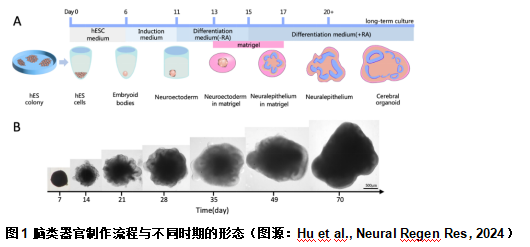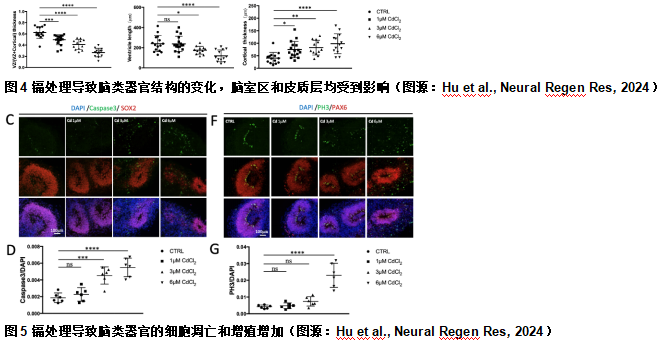NRR:同济大学及上海大学高正良团队建立脑类器官毒理测试平台并探究了镉的中枢神经毒性
撰文:胡岱玉
人类胎儿时期大脑极易受到周围环境中的毒素影响,可导致人脑早期发育缺陷,出现多种神经系统疾病[1, 2]。例如,孕妇接触隐藏在日常用品中的化学物质、聚合物和重金属会导致孕期和胎儿出生后出现多种神经发育障碍[3-9]。揭示和阐明环境污染物对人类神经系统的毒性范围及其内在机制非常重要,但传统实验模型在此类研究上有很多局限性。首先,二维和三维环境的差异会显著影响细胞的行为和表型,所以二维细胞水平的研究不能正确模拟体内的三维微环境。其次,传统的动物模型不能严格模拟人类大脑的发育过程。与其他动物相比,人脑是个独特而复杂的存在:它的再生能力较弱,通常受神经系统疾病的影响更为严重[10],它还具有一些其他动物模型不具备的特有的特征[11, 12]。例如啮齿类动物没有的外脑室下区以及在大小和神经元数量上区别于其他灵长类动物的大脑皮质。随着干细胞生物学的进展,大脑类器官作为一种新的研究平台出现,它不仅拥有着和人脑相似的细胞类型组成,还能模拟人脑内发现的特有结构和发育轨迹。相对于动物模型来说,它在便捷性和可重复性上也具有着很大的优势。
最近来自中国同济大学及上海大学高正良团队在《中国神经再生研究(英文版)》(Neural Regeneration Research)上发表了题为“Establishment of human cerebral organoid systems to model early neural development and assess the central neurotoxicity of environmental toxins”的研究,该研究构建了一个脑类器官系统,这个系统能稳定的从时间和结构上模拟人类胚胎大脑的发育进程,包括神经上皮发生、神经祖细胞产生和维持、神经元分化及皮质分层。此外,实验以重金属镉来证实该系统可用于模拟环境毒素导致的神经毒性。这种类器官模型稳定且可重复,可为神经发育和神经毒理学研究提供了一种强大而经济的动物模型替代品。
脑类器官平台做为神经毒理研究的一个新工具,常通过非引导法和引导法从人类胚胎干细胞或多能干细胞衍生而来[13],可由大脑中常见的祖细胞、神经元和神经胶质细胞组成。非引导法依赖于干细胞聚集体中的内在分化能力和自发形态发生,引导法则需要在不同时间点补充因子来诱导干细胞分化为所需的谱系,最终得到特定脑区的类器官。
为更一致和直观地再现早期大脑发育,高正良等优化了以往的脑类器官制作方法。在Lancaster的大脑类器官培养方法[14, 15]和宋红军的前脑类器官培养方法[16]的基础上发展而来的。在经典的大脑类器官培养方案中,类器官会在神经上皮快速扩张初期嵌入基质胶,以更好地形成花环状结构,之后在基质胶中生长并进行长期培养。但长期培养后发现,这种脑类器官在培养的中后期(35d后)往往会出现皮质细胞在基质胶中过度迁移,影响后期类器官组织的观察和质量控制,不利于毒理测试的进行。为解决这个问题,高正良等尝试将宋红军建立的前脑类器官培养技术融入到经典的非引导法脑类器官培养中,即只在神经上皮快速扩张期将类器官包埋到基质胶中,7d后再将类器官从基质胶中取出继续培养。这样既能保证神经上皮发育良好,又能避免长期培养的过程中脑类器官在基质胶中过度迁移。此外,还使用了比胰蛋白酶更温和的Accutase消化液,以减少对胚胎干细胞的损伤。通过这些改良,脑类器官的一致性和可重复性更高,更适合进行模型构建和毒理测试(图1)。

在体内神经干细胞/祖细胞的增殖、分化和模式化是大脑发育的决定性事件。在建立的脑类器官模型的发育过程中,皮质板出现并折叠,形成由神经干细胞/祖细胞组成的脑室区,神经祖细胞发生增殖,形成一层厚厚的干细胞池,并在培养中长期存活。与体内的发育情况类似,从第35天到第70天,显示Ki67阳性的增殖细胞随着时间的推移变得越来越有限和区域化,大多位于脑室区顶端边界,其数量向基底侧逐渐减少。进一步染色显示,S期细胞核和分裂中的细胞都精确定位在脑室区顶端,也就是说大多数神经祖细胞都集中在脑类器官组织的顶端表面分裂(图2)。高正良等认为这些高度阶段化、区域化和极化的现象在很大程度上再现了体内大脑皮质祖细胞发育的情况,表明神经祖细胞在自组织的能力下形成正确的极性,并为随后的神经分化和模式化奠定了基础。

在人类胎儿神经系统发育过程中,神经祖细胞以时间和空间严格调控的方式增殖、分化、迁移并逐渐形成由不同神经元组成的皮质层。此研究培育的人脑类器官组织在很大程度上再现了大脑皮质发育的模式化和分层。在第21天时的早期阶段,观察到的神经元还比较少,但随着神经发生的进行,从神经上皮产生的新生神经元明显增加。随着祖细胞的增殖和神经元的分化,皮质形成,并逐渐增厚,且神经元的持续分化和迁移导致早期皮质组织的扩张和分层的出现,这种分层随着培养时间拉长愈发明显(图3)。另外,在胚胎发育过程中神经祖细胞会大量增殖和扩增,由于这种增殖特性,胎儿大脑很容易受到环境压力的影响。细胞增殖和凋亡之间的平衡对胎儿大脑的发育至关重要,增殖或细胞死亡的异常都可能导致大脑发育缺陷和神经系统问题。因此也检测和评估了模型中的细胞死亡。检测不仅是从细胞核的排列形态上观察,还能检测到DNA双链断裂损伤的常用标志物γH2AX的变化以及细胞凋亡标志物之一Caspase-3的变化。正常脑类器官细胞的死亡区域化也很明显,与皮质层相比,具有大量分裂和活跃增殖特性的脑室区细胞凋亡水平更高。

接下来,高正良等利用该模型研究了常见神经毒素镉对人类早期大脑皮质发育的影响,即以1,3和6 μM的镉处理脑类器官。虽然最初各组之间没有明显的差异,但随着时间的推移,镉处理组类器官周围漂浮的细胞碎片开始增多。7d时,可见对照组的类器官结构紧凑、边缘呈现半透明,且光滑的状态,而镉处理的类器官组织透光性降低,边缘不再平滑并伴有脱落的碎片和细胞碎屑。第14天时,这种现象变得非常明显。同时镉的长期处理也抑制了脑类器官的生长,可见镉处理组与对照组相比显著变小,且镉浓度与类器官大小之间存在明显的相关性,即镉浓度越高,类器官越小。进一步切片染色发现,对照组类器官中的细胞形成了紧密整齐的分层结构,而镉处理过的类脑体则有很多被破坏到未能形成清晰的分层,还有一些虽然形成了分层结构,但不同区域的细胞都受到了影响,变得杂乱无章、排列松散。对类器官结构进行定量分析后发现,处理组类器官的皮质层厚度呈剂量依赖性变厚,脑室区长度减小且厚度大幅下降(图4)。接下来探究了可能导致类器官结构变化的细胞机制。镉处理过的类器官分层结构变得杂乱无章,排列松散,这种无序化伴随着成片组织脱落和细胞碎片的增加,似乎与细胞死亡相关,进一步观察发现细胞核的碎裂也证实了这一点。对Caspase-3的免疫染色进一步表明,镉处理以剂量依赖的方式增加了细胞凋亡(图5)。然后进行了PH3染色并对细胞增殖进行了量化,发现镉处理不仅没有抑制细胞增殖,反而以剂量依赖的方式刺激了细胞增殖。2组类器官增殖细胞的分布也相同,对照组的增殖细胞几乎全部位于脑室下区/脑室区内侧,符合正常生理情况。而在镉处理的类器官中,大多数增殖细胞散布在杂乱的皮质区域,这可能是由于细胞大量死亡导致生长状态混乱的类器官中细胞增殖的代偿性增加(图5)。

在此之前也有其他团队以自制的类器官系统上对镉的神经毒性进行了研究,例如Yin等[17]、Huang等[18],他们都和作者一样观察到了镉暴露会增加细胞凋亡,这与以往在人群和动物模型上的研究一致。然而,Huang等[18]研究表明,急性接触高浓度(40和80 μM)镉会抑制脑器质性细胞的增殖。高正良团队的研究进一步发现,长期低浓度镉暴露(3和6 μM)虽会引发细胞死亡并部分破坏类器官的发育,导致类器官塌陷或紊乱,但与早期2项研究报告的增殖抑制相反[17, 18],细胞增殖明显增加,这可能是一种代偿机制的结果。此外,Huang等[18]只研究了较高浓度(40和80 μM)的急性效应,Yin等[17]则使用了较低浓度(1 μM)。他们未能观察到增殖增加可能是由于实验设计不同。另外,此次研究报告了2项早期研究没有观察到的结构和生长缺陷:明场视野中可见长期低浓度镉处理的脑类器官的边缘塌陷,进一步的免疫荧光染色发现了脑室区和皮质层的结构和细胞变化。
总之,高正良等描述了一种改良的人类胚胎干细胞衍生的脑类器官,它能够稳定的重现人类早期大脑发育的主要时间和空间特征。同时观察了重金属镉对神经发育的影响,结果表明这种新改进的类器官系统可轻松应用于神经毒性建模。镉暴露会导致大量细胞死亡、神经祖细胞激活、增殖、早熟分化,并最终致使神经祖细胞耗竭,脑类器官发育的部分废止。这种新开发的类器官平台不仅能弥补其他动物模型或者单层培养系统在研究人类脑发育上的缺陷,并且具有方便性、灵活性和可控性,是动物模型的有力而经济的替代品。最后,该模型还是有很大的改进空间,比如缺乏免疫细胞和血管系统。高正良团队正在致力于建立更完善的免疫/血管化脑类器官模型,扩大其在模拟和研究人类大脑发育、疾病、神经毒性方面的实用性和准确性。
原文链接:https://doi.org/10.4103/NRR.NRR-D-23-00928
参考文献
[1] Cannon JR, Greenamyre JT. The role of environmental exposures in neurodegeneration and neurodegenerative diseases. Toxicol Sci. 2011;124(2):225-250.
[2] Fleming SM. Mechanisms of gene-environment interactions in Parkinson's disease. Curr Environ Health Rep. 2017;4(2):192-199.
[3] Rice D, Barone S, Jr. Critical periods of vulnerability for the developing nervous system: evidence from humans and animal models. Environ Health Perspect. 2000;108 Suppl 3(Suppl 3):511-533.
[4] Verstraeten SV, Aimo L, Oteiza PI. Aluminium and lead: molecular mechanisms of brain toxicity. Arch Toxicol. 2008;82(11):789-802.
[5] Tian LL, Zhao YC, Wang XC, et al. Effects of gestational cadmium exposure on pregnancy outcome and development in the offspring at age 4.5 years. Biol Trace Elem Res. 2009;132(1-3):51-59.
[6] Xu L, Huo X, Zhang Y, et al. Polybrominated diphenyl ethers in human placenta associated with neonatal physiological development at a typical e-waste recycling area in China. Environ Pollut. 2015;196:414-422.
[7] Vrijheid M, Casas M, Gascon M, et al. Environmental pollutants and child health-A review of recent concerns. Int J Hyg Environ Health. 2016;219(4-5):331-342.
[8] Braun JM. Early-life exposure to EDCs: role in childhood obesity and neurodevelopment. Nat Rev Endocrinol. 2017;13(3):161-173.
[9] Abbott LC, Nigussie F. Mercury toxicity and neurogenesis in the mammalian brain. Int J Mol Sci. 2021;22(14):7520.
[10] Hodge RD, Bakken TE, Miller JA, et al. Conserved cell types with divergent features in human versus mouse cortex. Nature. 2019;573(7772):61-68.
[11] Lui JH, Hansen DV, Kriegstein AR. Development and evolution of the human neocortex. Cell. 2011;146(1):18-36.
[12] Tuoc TC, Pavlakis E, Tylkowski MA, et al. Control of cerebral size and thickness. Cell Mol Life Sci. 2014;71(17):3199-3218.
[13] Qian X, Song H, Ming GL. Brain organoids: advances, applications and challenges. Development. 2019;146(8):dev166074.
[14] Lancaster MA, Knoblich JA. Generation of cerebral organoids from human pluripotent stem cells. Nat Protoc. 2014;9(10):2329-2340.
[15] Sutcliffe M, Lancaster MA. A simple method of generating 3D brain organoids using standard laboratory equipment. Methods Mol Biol. 2019;1576:1-12.
[16] Qian X, Jacob F, Song MM, et al. Generation of human brain region-specific organoids using a miniaturized spinning bioreactor. Nat Protoc. 2018;13(3):565-580.
[17] Yin F, Zhu Y, Wang Y, et al. Engineering brain organoids to probe impaired neurogenesis induced by cadmium. ACS Biomater Sci Eng. 2018;4(5):1908-1915.
[18] Huang Y, Dai Y, Li M, et al. Exposure to cadmium induces neuroinflammation and impairs ciliogenesis in hESC-derived 3D cerebral organoids. Sci Total Environ. 2021;797:149043.



